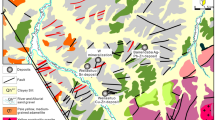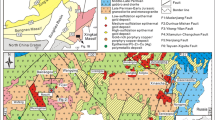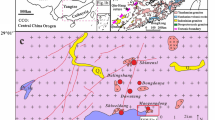Abstract
Tongkeng-Changpo is the largest tin deposit within the giant Dachang polymetallic tin ore field in Guangxi, southern China, which is part of a large skarn system associated with Cretaceous granitoids. The Tongkeng-Changpo mineralization consists of veins and stockworks in the upper levels and replacement stratiform orebodies (mantos) at lower levels. Based on textural relationships, three major mineralizing stages can be recognized: stage I with cassiterite, sulphides, stannite, tourmaline, and quartz; stage II with cassiterite, sulphides, sulphosalts, quartz, and calcite; and stage III with calcite as the main phase. The study of fluid inclusions has shown that there are two main fluid types: CO2 and NaCl-H2O. Homogenization temperatures are 270 to 365°C, 210 to 240°C, and 140 to 190°C for stages I, II, and III, respectively. Salinities range from 1 to 7 wt.% NaCl equiv. in the early ore stage and 3 to 10 wt.% NaCl equiv. in the late stages. Laser Raman Spectroscopy indicates that the inclusion fluids in stages I and II were of carbono-aqueous composition, with minor amounts of CH4 and H2S, whereas those in stage III were aqueous. Helium isotopic analyses of inclusion fluids indicate that the 3He/4He ratios in the ore veins are in between 1.2 to 2.9 Ra (Ra = 1.4 × 10−6, modern atmospheric ratio), and range from 1.6 to 2.5 Ra in the stratiform orebodies. This range of 3He/4He ratios is significantly higher than that of crustal fluids (0.01–0.05 Ra). The similar characteristics of fluid inclusions and their He isotopic composition, as well as age constraints, indicate that the ore veins and stratiform orebodies of the Tongkeng-Changpo deposit formed from the same hydrothermal system, likely related to granite intrusions of the Mesozoic Yanshanian tectono-thermal event. In addition, the high R/Ra ratios indicate a mantle contribution in the ore fluids.










Similar content being viewed by others
References
Bodnar RJ (1992) The system H2O-NaCl. PACROFI IV, program and abstracts. pp 108–111
Bozzo AT, Chen JR, Barduhn AJ (1973) The properties of hydrates of chlorine and carbon dioxide. In: Delyannis A, Delyannis E (eds) Fourth International Symposium on Fresh Water from the Sea 3:437–451
Burnard PG, Hu RZ, Turner G, Bi XW (1999) Mantle, crustal and atmospheric noble gases in Ailaoshan gold deposits, Yunnan Province, China. Geochim Cosmochim Acta 63:1595–1604
Cai HY, Zhang GL (1983) On submarine volcanism hot spring (exhalative) mineralization of the Dachang tin polymetallic deposit in Guangxi. Bull Inst Min Res Geol 1(4):13–21(in Chinese)
Cai MH, Liang T, Wu DC, Huang HM (2004) Structural feature and its control of mineralization of the Nandan-Hechi metallogenic belt in Guangxi Province. Geology and Exploration 6:5–10 (in Chinese with English abstract)
Cai MH, He LQ, Liu GQ, Wu DC, Huang HM (2006a) SHRIMP zircon U–Pb dating of the intrusive rocks in the Dachang tin polymetallic ore field, Guangxi and their geological significance. Sov Sci Rev Sect G Geol Rev 3:407–414 (in Chinese with English abstract)
Cai MH, Liang T, Wei KL, Huang HM, Liu GQ (2006b) Rb–Sr dating of the no.92 orebody of the Tongkeng-Changpo deposit in the Dachang tin polymetallic ore field, Guangxi, and its significance. Geology and Mineral Resources of South China 2:35–42 (in Chinese with English abstract)
Chappell BW, White AJR (1974) Two contrasting granite types. Pac Geol 8:173–174
Chen HD, Zeng YF, Li XQ (1989) Evolution of the sedimentation and tectonics of late Paleozoic Danchi basin. Acta Sedimentologica Sinica 7(4):85–96 (in Chinese with English abstract)
Chen YC, Huang MZ, Xu J, Hu YZ, Tang SH, Li YQ, Meng LK (1993) Tin deposits of Dachang. Geological Publishing House, Beijing, pp 53–311(in Chinese with English abstract)
Diamond LW (2001) Review of the systematics of CO2-H2O fluid inclusions. Lithos 55:69–99
Ding TP, Peng ZC, Li H, Li YH (1988) Stable isotope studies on several typical mineral deposits. Science and Technology Publishing House of Beijing, Beijing, pp 21–44 (in Chinese with English abstract)
Fu M, Changkakoti A, Krouse HR, Gray J, Kwak TAP (1991) An oxygen, hydrogen, sulfur, and carbon isotope study of carbonate-replacement (skarn) tin deposits of the Dachang tin field, China. Econ Geol 86:1683–1703
Fu M, Kwak TAP, Mernagh TP (1993) Fluid inclusion studies of zoning in the Dachang tin polymetallic ore field, People’s Republic of China. Econ Geol 88:283–300
Giggenbach WF (1986) The use of gas geochemistry in delineating the origin of fluid discharges over the Taupo volcanic zone: a review. In: 5th International Volcanological Congress, Volcanism, Hydrothermal Systems, and Related Mineralization, Hamilton, Newland, February 1986. Proceedings, pp 47–50
Han F, Zhao RS, Shen JZ, Hutchinson RW, Jiang SY (1997) Geology and origin of ores in the Dachang polymetallic tin ore field. Geological Publishing House, Beijing, pp 65–157 (in Chinese with English abstract)
Hu RZ, Zhong H, Ye ZJ, Bi XW, Turner G, Burnard PG (1998) Helium and argon isotopic geochemistry of Jinding large-scale lead–zinc deposit. Sci China Ser D 28(3):208–213 (in Chinese)
Hu RZ, Bi XW, Turner G, Burnard PG (1999) Helium and argon isotopic geochemistry of gold mineralizing fluid of Ailaoshan gold mineralization belt. Sci China Ser D 29:321–330 (in Chinese)
Jean-Baptiste P, Fouquet Y (1996) Abundance and isotopic composition of helium in hydrothermal sulfides from the East Pacific Rise at 13°N. Geochim Cosmochim Acta 60:87–93
Lattanzi P, Corazza M, Corsini F, Tanelli G (1989) Sulfide mineralogy in the polymetallic cassiterite deposits of Dachang, P. R. China. Mineral Deposits 24:141–147
Lei LQ (1986) Preliminary discussion of genesis of the Dachang Changpo polymetallic tin deposit. Mineral Deposits 5:87–96 (in Chinese)
Li YQ, Chen WS (1989) The ore-forming fluid of Dachang tin deposit. Acta Petrologica Sinica (3):12–24 (in Chinese with English abstract)
Liu B, Shen K (1999) Thermodynamics of fluid inclusions. Geological Publishing House, Beijing, pp 44–118 (in Chinese with English abstract)
Pašava J, Kříbek B, Dobeš P (2003) Polymetallic tin sulfide deposits in the eastern part of the Dachang tin field (South China) and the role of black shales in their origin. Mineral Deposits 38:39–66
Qin DX, Hong T, Tian YL, Chen JW (2002) Ore geology and technical economy of no.92 orebody of the Dachang tin deposit, Guangxi. Geological Publishing House, Beijing, pp 31–132 (in Chinese with English abstract)
Roedder E (1984) Fluid inclusions. Rev Mineral 12:25–35
Rui ZY, Li YQ, Wang LS (2003) Approach to ore forming conditions of ore fluid inclusions. Mineral Deposits 22:13–23 (in Chinese with English abstract)
Simmons SF, Sawkins FJ, Schulutter DJ (1987) Mantle-derived heliumin: two Peruvian hydrothermal ore deposits. Nature 329:429–432
Stuart FM, Turner G, Duckworth RC, Fallick AE (1994) Helium isotopes as tracers of trapped hydrothermal fluids in ocean-floor sulfides. Geology 22:823–826
Stuart FM, Burnard P, Taylor RP, Turner (1995) Resolving mantle and crustal contributions to ancient hydrothermal fluids: He–Ar isotopes in fluid inclusions from Dae Hwa W-Mo mineralisation, South Korea. Geochim Cosmochim Acta 59:4663–4673
Tanelli G, Lattanzi P (1985) The cassiterite-polymetallic sulfide deposits of Dachang (Guangxi, People’s Republic of China. Mineral Deposits 20:102–106
Wang DH, Chen YC, Chen W, Sang HQ, Li HQ, Lu YH, Chen KL, Lin ZM (2004) Dating of the Dachang superlarge tin polymetallic deposit in Guangxi and its implication for the genesis of the no. 100 orebody. Acta Geol Sinica (English edition) 78:452–458
Ye XS, Yan YX, He HZ (1999) The mineralization factors and tectonic evolution of Dachang superlarge tin deposit, Guangxi, China. Geochim 28:213–221 (in Chinese with English abstract)
Zhang GL, Cai HY (1987) Genesis of the Dachang Changpo polymetallic tin deposit. Geol Rev 33:426–436 (in Chinese)
Zhang WH, Chen ZY (1993) Geology of fluid inclusions. China University of Geosciences Press, Wuhan, pp 83–156 (in Chinese)
Zhao KD, Jiang SY, Xiao HQ, Ni P (2002) Origin of ore-forming fluids of the Dachang Sn-polymetallic ore deposit: evidence from helium isotopes. Chin Sci Bull 12:1041–1045 (English edition)
Acknowledgements
We are grateful to Huang Huiming, Wu Decheng, and Wei Keli for their kind help during field work. We also thank Dr. Fan Hongrui for his constructive suggestions on earlier versions of the manuscript. We wish to express our sincere appreciation to Pierfranco Lattanzi, Georges Beaudoin, and Bernd Lehmann for their constructive criticism. Franco Pirajno publishes with the permission of the Executive Director of the Geological Survey of Western Australia.
Author information
Authors and Affiliations
Corresponding author
Additional information
Editorial handling: G. Beaudoin
Rights and permissions
About this article
Cite this article
Minghai, C., Jingwen, M., Ting, L. et al. The origin of the Tongkeng-Changpo tin deposit, Dachang metal district, Guangxi, China: clues from fluid inclusions and He isotope systematics. Miner Deposita 42, 613–626 (2007). https://doi.org/10.1007/s00126-007-0127-5
Received:
Accepted:
Published:
Issue Date:
DOI: https://doi.org/10.1007/s00126-007-0127-5




